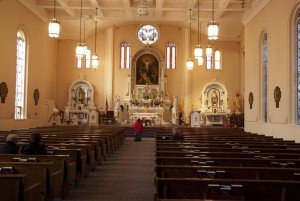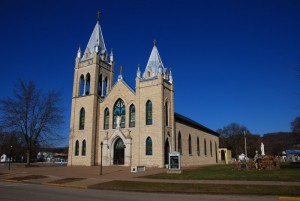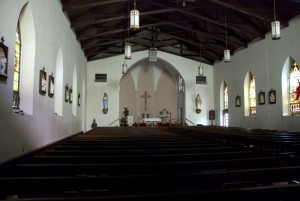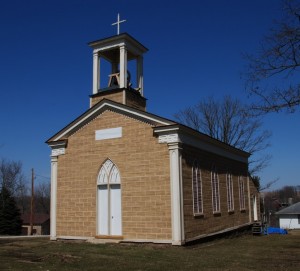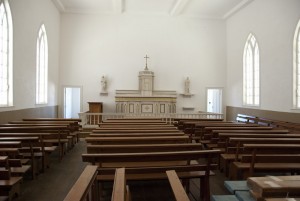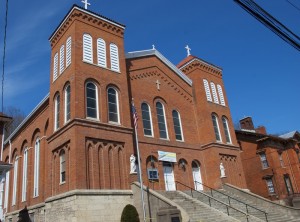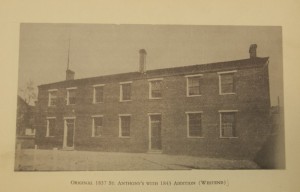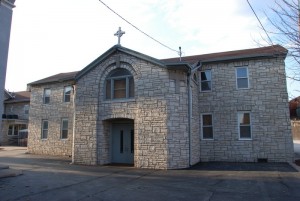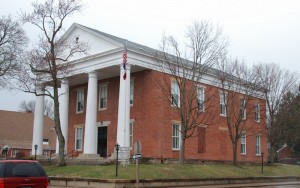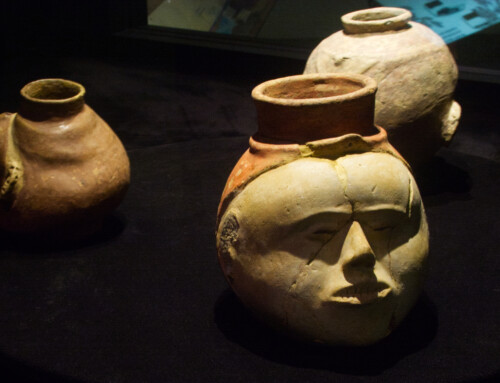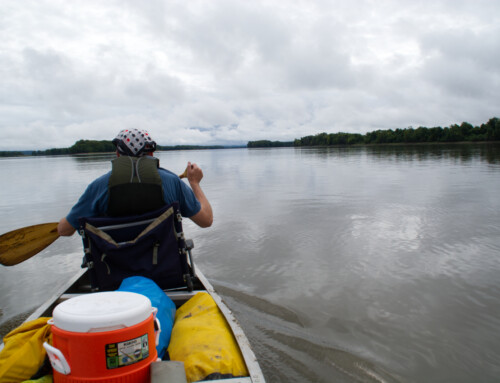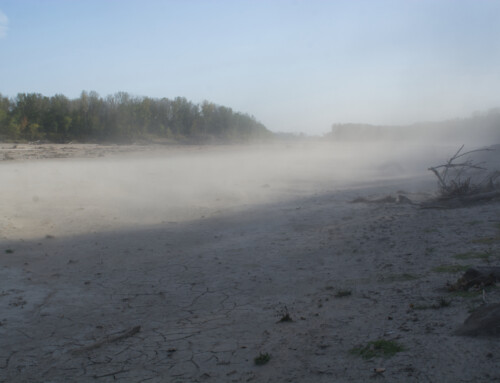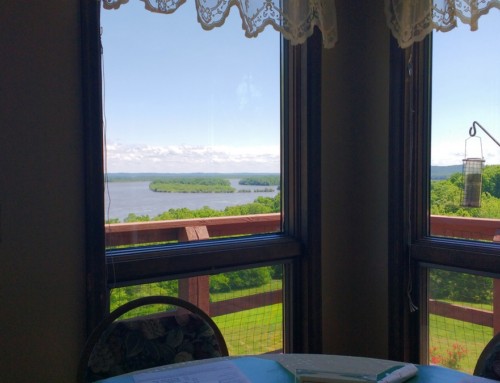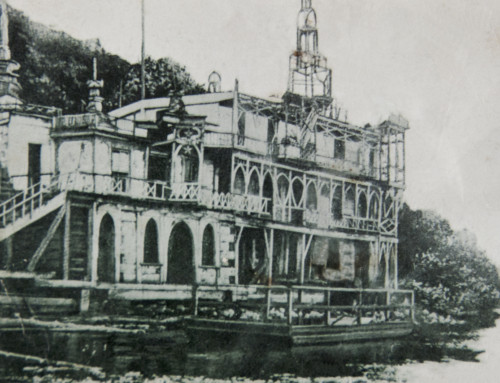Nobody would have imagined that the young Milanese Carlo Gaetano Samuele Mazzuchelli was destined to leave his mark on the rivertowns of the Upper Mississippi River.
He was born November 4, 1806, in Milan, Italy, to a wealthy merchant family with deep roots in the Lombardy region. The Mazzuchellis lived on the stately Piazza Fontana, in the shadows of one of the world’s great houses of worship, the Milan Duomo, and within walking distance of the abandoned Dominican priory of Santa Maria delle Grazie, which is the home of Leonardo da Vinci’s masterpiece The Last Supper. The young Mazzuchelli was educated at the Collegio di Sant’ Antonio, a private academy in Lugano, Switzerland.
A political career seemed inevitable, but, at the age of 17, he shocked his family when he announced that he felt called to a religious vocation. A short time later he joined the Dominican Order and gave up a familiar and privileged life for the alien world and privation of the American frontier.
At 22, he endured a grueling, seven-month journey to America, arriving in Cincinnati in 1828 with only a crude understanding of English. After his ordination in 1830, he was assigned to serve Native Americans and fur traders in the outposts of the Northwest Territory: Mackinac Island, Green Bay, and Sault Ste. Marie. In 1835 his mission shifted to the growing communities in the lead mining region around Galena, Illinois, and Dubuque, Iowa. Father Mazzuchelli arrived just after the Black Hawk War, at a time when thousands of new settlers were streaming into the region in search of riches and a new life. For eight years, he served Catholics in growing communities along the Upper Mississippi River from Prairie du Chien to Fort Madison, Iowa.
During these years, the Mississippi River was his interstate highway. In warm months, Mazzuchelli was a regular passenger on steamboats destined for towns in his ministry or to St. Louis for his annual retreat, often riding gratis because many steamboat captains declined to charge him. In winter, the ice on the Mississippi was usually strong enough to support a man on horseback. In February 1843, for example, Mazzuchelli rode 10 miles across the frozen Mississippi from Fort Madison, Iowa, to Nauvoo, Illinois, to discuss theology with Joseph Smith. Smith, the leader of the Church of Jesus Christ of Latter Day Saints, was assassinated about a year later.
Spring was a much more challenging time for river travel. In his memoirs, Mazzuchelli wrote of a crossing in March 1838, when ice and a poorly chosen boat nearly put an end to his ministry: ” … the drifting ice, more than a foot thick and in masses of enormous size, greatly increased the danger, for if one of these had struck the boat, it would surely have sent it to the bottom… The four passengers were already sitting in the water; the priest and the steersman were kneeling in it -for the boat was only four inches above the surface when, thanks be to God, an island offered a safe refuge.”
Exhausted and ill in 1844, Mazzuchelli returned to Italy for a year to recuperate and visit his family, although his idea of rest was to write a two-volume memoir describing his experiences on the American frontier. His book provided much detail on his architectural legacy, most of which comes from the period when he was based in Galena. While his ultimate purpose was to save souls, he devoted considerable energy to the construction of buildings to serve that aim.
For someone with no apparent training in architecture, his buildings are stout and show a diversity of design influences—Romanesque, Gothic, Greek Revival and Italian Renaissance—and are built of wood, stone or brick. He also knew how to get the most church for the money. Using a combination of salesmanship, donated materials and labor, and his own frugality, he stretched available resources to build churches that were often a little grander than a community could afford. Occasionally, he reached too far, and contributions from other sources were needed to finish construction.
On a bitterly cold February day in 1864, Mazzuchelli responded to an urgent request to visit a seriously ill woman who lived four miles out of town. He went immediately, not dressing properly for the freezing weather. The next day he developed pneumonia, and a week later he died at his rectory in Benton, Wisconsin. He was buried in Benton’s St. Patrick’s cemetery.
This Italian man, born into a privileged world, who chose a life of poverty and service on the American frontier, helped establish the foundations for community life in burgeoning towns of the Upper Mississippi Valley. He has left us a remarkable legacy.
Father Mazzuchelli’s labors and virtues have received more recognition in recent years. Papers claiming miracles associated with him were sent to the Vatican for review a few years ago, which may lead to the pope declaring Mazzuchelli as “blessed”—one step away from sainthood.
Most of the surviving buildings designed by Mazzuchelli, listed here, are near the Great River Road.
Other extant buildings that Mazzuchelli helped design include the Jo Daviess County Courthouse in Galena (the Greek Revival structure is hidden behind a Second Empire addition completed in 1900), the former St. Rose Academy in Galena (228 Bench St., now a private residence), the former Sinsinawa Mound College (now a residence for the Dominican sisters), and St. Patrick Church in Benton, Wisconsin.
St. Mary’s Church; Galena, Illinois (1860)
St. Mary’s Parish was established in 1850 to serve a growing population of German immigrants in Galena. Mazzuchelli designed the brick church and delivered a sermon at the first mass, in December 1860. He also donated a marble altar to the parish, for which he paid $140. The steeple was completed in 1875 and the parsonage in 1876. The high altar and the painting of the Assumption just above it were completed in 1878. The entire church has been through a series of renovations in the last 20 years and is in excellent condition.
St. Gabriel Church; Prairie du Chien, Wisconsin (1840)
Mazzuchelli first visited Prairie du Chien in September 1832, after an eight-day horseback trip through the wilderness from Green Bay. ln the 1830s, Prairie du Chien was a small village still important to the fur trade. The town’s 500 Catholics needed a substantial building, so Mazzuchelli designed a 50-by-100-foot stone church in a style that he described as “a chaste Gothic.”
Mazzuchelli made many trips to Prairie du Chien to monitor the construction, even quarrying stone himself for a few days. When the project turned out to be too expensive for the community, the Dubuque Diocese contributed $1,400 to complete it.
The church has undergone several alterations, including removal of the original bell tower and a 1908 expansion that added a vestibule and towers on the west side of the church and an east-side addition that increased the depth of the altar and added sacristies. Drawings displayed on a wall inside the vestibule chronicle the changing appearance of the church.
St. Augustine Church; New Diggings, Wisconsin (1844)
When St. Augustine was built in 1844, the community of New Diggings was a wild place, full of lead miners. Thousands of men lived in camps and spent their leisure time drinking, gambling, and cavorting with prostitutes. Mazzuchelli built the church in an attempt to draw the miners out of the bars and brothels.
The building is predominantly Greek Revival in style with a bit of Gothic flair (the pointed arches on the windows). St. Augustine was closed in 1925 and sat neglected until 1959, when the Mazzuchelli Assembly 4th Degree Knights of Columbus adopted the building. In the Iast few years the Knights have undertaken an ambitious restoration funded by $500,000 in donations.
This is the only building designed by Mazzuchelli that is essentially unaltered from his initial plan, right down to the original pews and plaster walls (and the lack of electricity, running water, and a modern heating and cooling system). The exterior was restored in 2007 by replicating the original rusticated finish, a common 19th century technique used to give wood the appearance of stone.
St. Michael’s Roman Catholic Church; Galena, Illinois (1856-1863)
When Mazzuchelli arrived in 1835, a quarter of Galena’s 800 residents were Catholic. Its population grew five-fold by 1843. The first St. Michael’s Church was completed in 1842 for the astronomical sum of $74,000, but was destroyed by fire just 14 years later. Mazzuchelli designed the new church. Construction started in 1856, but was not completed until 1863.
At 135 feet long and 60 feet wide, this is the largest church designed by Mazzuchelli and is arguably his finest building. The red brick exterior has Italian Renaissance and Romanesque influences. Its fortress-like exterior is softened by a graceful symmetry and decorative brickwork. To eliminate the need for columns inside the spacious nave, Mazzuchelli designed a special truss to support the roof, an innovation well ahead of its time. The interior has been through several renovations, most recently in the late 1980s.
Old St. Mathias Church; Muscatine, Iowa (1842)
In 1841 Bloomington, Iowa, (now Muscatine) was a boom town of 800 people, ten of whom were Catholic. With an eye toward the future, Mazzuchelli and Dubuque’s Bishop Loras decided to build a small chapel to serve the Catholic community until its numbers could support a larger church. Mazzuchelli designed and supervised construction of the small 20-by-30-foot frame chapel in 1842 for the bargain price of $1,100. It was reportedly built in Prairie du Chien, disassembled, and floated on rafts 180 miles down the Mississippi River.
The building was sold in 1856, when the parish built a new church on Eighth Street. Threatened with demolition in 1934, the community rallied and moved the structure from its original location on Cedar Street to the grounds of the new St. Mathias Church. Restoration took several years. The interior offers a glimpse of frontier worship: a small, practical space built with minimal ornamentation, where the spectacle was the service rather than the space.
An identical frame church, St. Andrew, was built around the same time and floated down the Mississippi to Bellevue, Iowa. It no longer exists.
St. Anthony Church; Davenport, IA (1838-39)
When construction began in 1837, Davenport was a village of only 100 people, of which Mazzuchelli estimated 25 were Catholic. The original two-story brick building, financed in part by the town’s founder, Antoine LeClaire, was only 25 by 40 feet, with the priest’s living quarters and a school on the first floor, and the chapel on the second.
By 1843, Davenport’s population was exploding and a bigger church was needed. The east wall of the church was removed, and a 35-foot extension added. As the population continued to grow, a new church was built in 1853. The Mazzuchelli building was used as a school until 1968 and is now the parish religious education center.
In 1947, the original brick exterior was covered in stone to match the church and rectory. The parish eventually hopes to restore the second-floor chapel to its 1840s appearance. Check back in a couple of years.
North Lee County Courthouse; Fort Madison, IA (1841-42)
In 1841, a popular vote was scheduled to settle the issue of which Lee County community would be the county seat. In advance of the vote, political leaders of Fort Madison acted to sway the election by allocating $8,000 for a new courthouse and approving the purchase of land. Fort Madison won.
Mazzuchelli designed a Greek Revival building with four massive columns. Construction of the courthouse began shortly after the election and was finished in the summer of 1842, at a cost of $13,559. In 1876, the building was enlarged with a 24-by-50-foot addition to the north, and a cupola was installed. The courthouse was gutted by fire on March 29, 1911, but the foundation and substantial walls remained, and the two original safes protected the county records. The community decided to restore the courthouse, minus the cupola. Today, the North Lee County Courthouse is the oldest courthouse in continuous use in Iowa.
**Read more about the communities Father Mazzuchelli served in Road Tripping Along the Great River Road, Vol. 1. Click the link above for more. Disclosure: This website may be compensated for linking to other sites or for sales of products we link to.
Visiting Mazuchelli Sites
- St. Augustine, New Diggings, WI: just off County Highway W, east of Hazel Green. The church is open on Sunday afternoons from 1 to 4 p.m. from June 1 until the last Sunday in October.
- St. Michael’s Church, 227 S. Bench St., Galena, IL: Call the parish office, 815-777-2053, for Mass times, and to arrange a tour of the building, which is usually locked.
- Church of St. Mary, 406 Franklin, Galena, IL: The church is usually locked. Call to arrange a visit and for Mass times, 815-777-0134.
- St. Anthony Catholic Church, 417 N. Main St., Davenport, IA: The original 1853 church building is now used for religious education and is not generally open for tours. Call the parish office, 563-322-3303, for a tour and for Mass times.
- Old St. Mathias Church, 215 W. Eighth St., Muscatine, IA: You are welcome to tour the old church, but you must contact the parish office in advance to set up a time. Weekdays are best, 563-263-1416.
- North Lee County Courthouse, Seventh St. and Avenue F, Fort Madison, IA: Still a functioning courthouse, the building is open during normal business hours. Historic photos hang in the first-floor lobby. Tours can be arranged by calling the courthouse in advance, 319-376-2341.
- Sinsinawa Mound, located near Hazel Green, WI: Located on County Highway Z, has a permanent exhibit about Mazzuchelli, 608-748-4411. Open daily 9 to 4. No charge.
This article originally appeared in Big River Magazine (Jan-Feb 2009).
©Dean Klinkenberg, 2009, 2016
Community-supported writing
If you like the content at the Mississippi Valley Traveler, please consider showing your support by making a one-time contribution or by subscribing through Patreon. Book sales don’t fully cover my costs, and I don’t have deep corporate pockets bankrolling my work. I’m a freelance writer bringing you stories about life along the Mississippi River. I need your help to keep this going. Every dollar you contribute makes it possible for me to continue sharing stories about America’s Greatest River!


